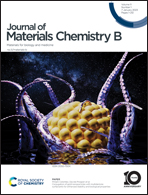Photoinduced micropatterning on biodegradable aliphatic polyester surfaces for anchoring dual brushes and its application in bacteria and cell patterning†
Abstract
In view of intrinsic challenges encountered in surface patterning on actual biomaterials such as the ones based on biodegradable polymers, we have demonstrated an innovative strategy to create micro-patterns on the surface of tartaric acid based aliphatic polyester P (poly(hexamethylene 2,3-O-isoprpylidentartarate)) without significant loss of its molecular weight. Around 10 wt% PAG (photoacid generator, 2-(4-methoxystyryl)-4,6-bis(trichloromethyl)-1,3,5-triazine) was purposefully encapsulated in a polyester matrix comprising of P and PLA (polylactide) at a ratio of 5 : 95. With the help of a photomask, selective areas of the matrix were exposed to UV radiation at 395 nm for 25 min to trigger the acid release from PAG entrapped unmasked areas for generating hydroxyl functionality that was later converted to an ATRP (atom transfer radical polymerization) initiating moiety on the irradiated domain of P. In subsequent steps, spatio-selective surface modification by surface initiated ATRP was carried out to generate an alternate pattern of polyPEGMA (poly(ethylene glycol)methyl ether methacrylate) and polyDMAPS (poly(3-dimethyl-(methacryloyloxyethyl)ammonium propane sulfonate)) brushes on the matrix. The patterned surface modified with dual brushes was found to be antifouling in nature (rejection of >97% of proteins). Strikingly, an alternate pattern of live bacterial cells (E. coli and S. aureus) was evident and a relatively high population of bacteria was found on the polyPEGMA brush modified domain. However, a complete reverse pattern was visible in the case of L929 mouse fibroblast cells, i.e., cells were found to predominantly adhere to and proliferate on the zwitterionic brush modified surface. An attempt was made to discuss a plausible mechanism of selective cell adhesion on the zwitterionic brush domain. This novel strategy employed on the biodegradable polymer surface provides an easy and straightforward way to micro-pattern various cells, bacteria, etc. on biodegradable substrates which hold great potential to function as biochips, diagnostics, bacteria/cell microarrays, etc.



 Please wait while we load your content...
Please wait while we load your content...